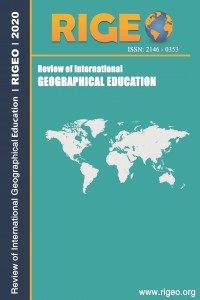Primary Geography Education in China: Past, Current and Future
Primary Geography Education in China: Past, Current and Future
In
China, geography education in primary schools (grades 1 to 6) has not been
emphasized, although some scholars have done research in this area. In order to
deepen the understanding of primary geography education in China, this paper
examines its history, current situation, and future trends. The authors used
the method of document analysis and review of associated literature,
interviews, and a survey instrument to collect data from 55 primary schools.
The data suggested that geography education is not significant in primary
schooling, the quality of teachers is limited, and geography curriculum
resources have not been fully developed.
Keywords:
Primary geography education, survey study geography curriculum, curriculum implementation, China,
___
- Catling, S. (1999). Issues for Research in UK Primary Geography. International Research in Geographical and Environmental Education, 8(1), 60-65.
- Chen, E. (1998). Geography Education and National Condition. Beijing: People's Education Press.
- Chen, E., & Wu, L. (1988). Geographical Curriculum in Basic Education before 1949. Curriculum, Teaching Material and Method, 8(6), 57-64.
- Department of Basic Edcuation. (2001). The Outlines for Curriculum Transformation in Basic Education. Ministry of Edcuation of the People's Republic of China: http://www.moe.gov.cn/publicfiles/business/htmlfiles/moe/s8001/201404/167343.html.
- Department of Basic Education. (2001). The Experimental Directives for Curriculum in Compulsory Education. Ministry of Education of People's Republic of China. http://www.moe.gov.cn/publicfiles/business/htmlfiles/moe/moe_711/201006/xxgk_88602.html.
- Department of Basic Education. (2001). The Outlines for Curriculum Transformation in Basic Education . Ministry of Education of the People's Republic of China. http://www.moe.gov.cn/publicfiles/business/htmlfiles/moe/s8001/201404/167343.html.
- Department of Basic Education. (2005). The Regulations about Choosing Textbooks. Ministry of Education of the People's Republic of China. http://www.moe.edu.cn/publicfiles/business/htmlfiles/moe/moe_714/201410/177733.html.
- Edelson, D. (2014). Geo-Literacy: Preparation for 21st Century Decision-Making. National Geographic Society. http://education.nationalgeographic.com/media/file/Geo- Literacy_Backgrounder.pdf.
- Felton, R. (2004). Great Leap Forward?. Meltal Powder Report, 59(9), 3.
- Huang, W. (2002). Teacher Education Profession and Curriculum Transform. Curriculum, Teaching Material and Method, 64-67.
- Lin, P. (2014). The Textbooks by Zhang Xiangwen for Primary and Middle Schooling. Journal of Capital Normal University (Social Sciences Edition), (2), 145-151.
- Li, Q. (2003). The Illiteracy Eradication Campaign during Great Leap Forward. Contemporary China History Studies, 10(3), 54-61.
- Li, W. (2011). History and Changes of Geographical Textbooks before Liberation. Education of Geography, 32(5), 4-6.
- Ministry of Education. (1999). Regulation of Teacher Continuing Education for Basic Schools. The Central People's Government of the People's Republic of China. http://big5.gov.cn/gate/big5/www.gov.cn/fwxx/content_2267058.htm.
- Ministry of Education. (2001). Science Standards for Grade 3-6 (Experimental Version). Beijing, China: Beijing Normal University Press.
- Ministry of Education. (2003). Geography Standards for Grade 10-12 (Experimental Version). Beijing, China: Beijing Normal University Press.
- Ministry of Education. (2011). Geography Standards for Grade 7-9. Beijing, China: Beijing Normal University Press.
- Ministry of Education. (2011). Morality & Society Standards for Grade 3-6. Beijing, China: Beijing Normal University Press.
- National Bureau of Statistics of China. (2014). China Statistical Yearbook. National Bureau of Statistics of the People's Republic of China. http://www.stats.gov.cn/tjsj/ndsj/2014/indexeh.htm. National Council for Geographic Education. (2012). Geography for Life. National Council for Geographic Education. http://www.ncge.org/geography-for-life.
- Nia, J., Southworth,G., & Campbell, P. (1992). Whole School Curriculum Development in the Primary School. Routledge.
- People Daily. (2003). The Great Leap Forward Formally began on February 2, 1958. People: http://www.people.com.cn/GB/historic/0202/432.html.
- Premier's Technology Council. (2010). A Vision for 21st Century Education. Victoria: British Columbia Premier's Technology Council.
- Schell, E. (2014). A Road Map to 21st Century Geography Education. California Council for the Social Studies, 2(2), 1-10.
- Su, Y. (2014). Geography Learning Method Based on Metacognition. Teaching Reference of Middle School Geography, (4), 34-38.
- The National People's Congress. (1993). Teachers Law of the People’s Republic of China. The Central People's Government of the People's Republic of China. http://www.gov.cn/banshi/2005-05/25/content_937.htm.
- Tian, B. (1995). Primary Education. Fuzhou: Fujian Education Press.
- Wang, G. (2001). The History and Rethinking of National Eight Curriculum Reforms. Journal of Liaoning Educational Administration Institute, 28(5), 13-15.
- Wang, X., & Yuan, X. (2004). Components and Features of Geographical Literacy. Curriculum, Teaching Material and Method, (12), 64-67.
- Wiegand, P. (1993). Children and primary geography. London: Continuum International Pubish Group.
- Yu, L. (2012). Thinking about Geography Education Transform in Middle Schools. Geography Teaching, (5), 4-7. Zhang, J., & Yuan, X. (2013). Primary Geographical Textbooks in Late Republic China. Geography Teaching, (17), 4-7.
- Zhou, Q. (2005). The Cases of the Great Leap Forward about Education in 1958. Party History Research & Teaching, (1), 84-88.
- ISSN: 2146-0353
- Başlangıç: 2011
- Yayıncı: Eyüp ARTVİNLİ
Sayıdaki Diğer Makaleler
Primary Geography Education in China: Past, Current and Future
Xiaowei XUAN, Yushan DUAN, Yue SUN
Defining Primary Geography from Teachers’ Expertise: What Chilean Teachers Mean by Geography
Victor SALINAS-SILVA, Patricio PEREZ-GALLARDO, Andoni ARENAS-MARTIJA
Understanding and Teaching the Australian Curriculum: Geography for Primary Schools
South African Teachers’ Perceptions of the Primary Geography Curriculum: An Exploratory Study
Primary Geography in Australia: Pre-Service Primary Teachers’ Understandings of Weather and Climate
Primary Geography in the Republic of Ireland: Practices, Issues and Possible Futures
